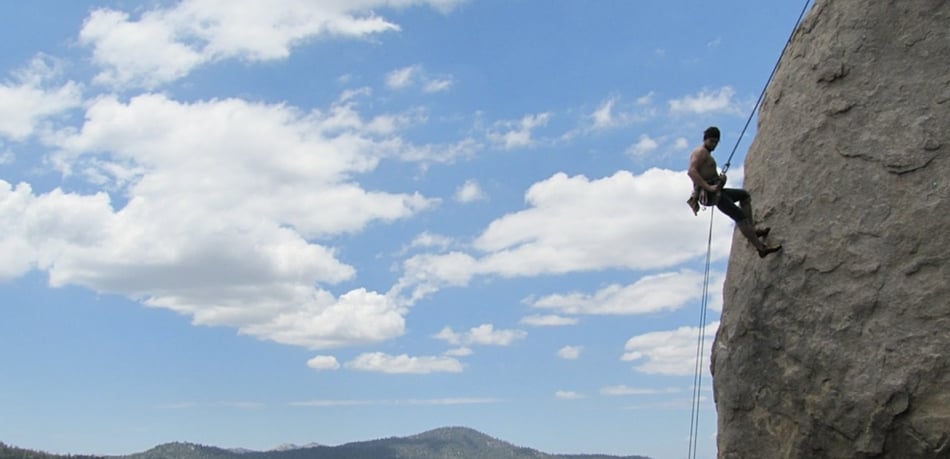
Rappelling with a backpack seems simple, but there are actually a few tricks that can make it easier. I went looking to find the best tips to keep you safe.
So how do you rappel with a backpack? While rappelling with a backpack, you can either wear it normally around your shoulders, or attach it via a tandem rappel. Which option you chose will depend on the weight of the bag.
Most of the time, rappelling with a backpack can be performed just as a normal rappel. However, you do need to consider how bulky the bag is before you commit to simply wearing it as you usually would. If you have too much gear, the pack can throw off your balance and compromise the safety of your rappel. In these instances, it can become necessary to attach the bag to your harness via a tandem line so that it doesn’t affect your centre of gravity.
Both of these techniques are important to know; I’ve compiled a quick guide below that walks through the entire process.
What’s The Problem When Rappelling With a Backpack?
As I mentioned above, the main danger in rappelling with a backpack is how it will affect your weight on the rappel. To understand why, it’s first important to understand what’s going on in terms of physics while you’re abseiling.
In most instances, a person who’s rappelling will be wearing a harness attached to their waist/legs to help them stay connected to the ropes. These harnesses are great in a lot of ways: they’re affordable, portable, and they allow you to comfortably ‘sit’ while rappelling.
They do, however, have on element that makes it difficult to rappel while carrying a load: your attachment point to the rope is located at your waist. For most people, the upper body is already heavier than the legs; this makes them top-heavy when rappelling.

Proper rappelling technique and the shape of your harness usually work together to combat this effect and keep you right-side-up during your rappels. By activating your core and taking advantage of the ‘sit-down’ position I was talking about earlier, you can stay in a neutral position for thee length of the abseil.
If you add a lot of weight to your back, though, this position becomes a lot more difficult to maintain. There’s a chance that you may flip over, so that your legs are pointed skywards and your head is dangling towards the ground.
Why Is This Bad?
You might be wondering, is this dangerous? The short answer is yes. A position like this can be incredibly compromising to the safety of your rappel.
First of all, this makes it much harder to enact any sort of control with your brake hand. The rope is a lot harder to hold on to when you’re turned upside down, and you increase the odds of losing your grip and falling.
Even if this doesn’t happen, there’s still a lot of danger associated with flipping over on the rappel. Forget the fact that you might swing in to a cliff face and hurt yourself, or the damage that can be done to your equipment by putting strain on it that way. The real danger here is actually getting stuck; if you flip and you’re heavily weighed down by a backpack, it can be extremely difficult to return to a proper position.

This leads to a whole world of problems. In this instance, you essentially have three options:
- Sit there and wait for a rescue.
- Drop your bag (difficult to do while hanging upside down, and potentially damaging to what’s inside) so you can finish the rappel.
- Attempt to finish the rappel while upside down (not recommended!)
As you can see, this is clearly a situation that you want to avoid. The trick to doing so is preventing your bag from having too much influence on your centre of gravity.
How Heavy Is Too Heavy?
Being inverted might be cool when you’re dogfighting (Top Gun reference, anybody?), but it’s clearly not ideal when performing a rappel. The question now becomes: how heavy does your bag have to be before this is dangerous?
The answer varies from person to person, depending on:
- How much you weigh
- How your bag’s load is distributed
- How much experience you have rappelling
Terrain also plays a factor: if you’re able to brace your feet against a rock face, it’s easier to maintain a position than if you’re simply dangling in mid air.
Even with all of that considered, though, there isn’t that much margin for rappelling with a pack on. If you’re a seasoned vet and you know what you’re doing, you might be able to get away with wearing 20 pounds while descending.
I know that doesn’t sound like much, but try to put it in to context. My bag when I go on overnight hikes weighs thirty pounds, and anyone who’s ever backpacked before knows how heavy that feels. Twenty pounds is quit a lot to be rappelling with, even if all of the other conditions are in your favour.
Because of that, I wouldn’t recommend doing it with anything that weighs more than 10-12 pounds. In other words, you can fit your Nalgene, a spare sweater, and maybe some snacks or miscellaneous gear in your bag; anything other than that and it won’t be safe to rappel with.
So What’s the Alternative?
The alternative to wearing the bag on your back is to use what’s called a tandem rappel. A tandem rappel is when you dangle the bag between your legs, thus removing any concerns you may have about it throwing off your centre of gravity. This is the recommenced technique for any bag that’s heavier than the parameters set above.
Tandem rappels can be a little confusing. Here are some of the questions I encountered when doing research:
How Does It Work? You use a length of rope to attach the bag to your harness when performing the rappel, so that its weight is pulling directly down on your waist. This shifts your centre of gravity into a more desirable position.
Where Do You Attach The Bag? The bag can hang from your belay loop, a fully-reinforced haul loop, or even the rappel device itself. Hanging it from one of the side loops of your harness is not recommended; those loops may not be strong enough to support the weight, and it can make you lopsided.
How Do You attach The Bag? A sling or short piece of cordlette will work to attach the bag to your harness. Carabiners are best for attaching the back to the cordlette, as they’re easier to undo than knots. If you’re out of ‘biners, though, knots will work fine.
Is it Uncomfortable? Yes, rappelling in tandem can sometimes be uncomfortable (especially for men), as it tends to squeeze around the groin area. This can usually be mitigated by attaching the bag to the rappel device, not your own harness.
How To Tandem Rappel With a Backpack
Now that we know a little bit more about tandem rappelling, here’s a step-by step process for tandem rappelling with your backpack:
- Prepare for the rappel as you normally would, attaching your device, tying a backup knot, and performing safety checks.
- While still on flat ground, remove the backpack and place it by your feet.
- Clip (or tie) a sling to your harness or rappel device
- Take the other end of the sling and attach it to the backpack. Knowing where to attach it can vary from bag to bag, but I usually find the top loop is easiest (as long as it’s strong enough to support the bag’s weight).
- While keeping your brake hand on the rope, pick up the bag with your other hand.
- Walk backwards slowly in the direction of your rappel until your weight is on the rope.
- Once you’re in the air, slowly lower the bag down so that it’s hanging between your legs.
- Perform the rest of the rappel as you normally would, slowing down near the bottom so that your bag doesn’t impact the ground too hard.
- Untie your bag and clean the rappel.
So there we go! Rappelling with a backpack can be tricky, but when done properly it doesn’t need to make your rappel any more dangerous.
Related Questions
Can You Rock Climb In a Backpack? Rock climbing in a backpack is completely safe, and sometimes necessary. It can throw off your bodyweight and make certain moves more difficult, however, so it’s recommended you get some practice in before attempting it.
